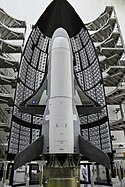Boeing X-37
 Egzemplarz OTV-1 po wylądowaniu (2010) | |
| Dane podstawowe | |
| Państwo | |
|---|---|
| Producent | |
| Typ | bezzałogowy wahadłowiec kosmiczny |
| Konstrukcja | kompozytowa |
| Załoga | 0 |
| Historia | |
| Data oblotu | 22.04.2010 – 3.12.2010 |
| Liczba egzemplarzy | 2 |
| Dane techniczne | |
| Napęd | 1 × Rocketdyne AR2-3 |
| Ciąg | 29,3 kN |
| Wymiary | |
| Rozpiętość | 4,5 m |
| Długość | 8,9 m |
| Wysokość | 2,9 m |
| Masa | |
| Startowa | 4,99 t |
| Dane operacyjne | |
| Użytkownicy | |
| NASA/DARPA (X-37A), USAF (X-37B) | |
| Rzuty | |
 | |
Boeing X-37 – amerykański bezzałogowy wahadłowiec kosmiczny, służący do testowania technologii kosmicznych. Został wykonany w dwóch egzemplarzach: OTV-1 (Orbital Test Vehicle 1) i OTV-2. X-37B wynoszony jest na orbitę rakietą nośną Atlas V lub Falcon 9. Wykorzystywany przez siły powietrzne USA. Pierwszy lot orbitalny przeprowadzono w 2010 roku (OTV-1).
Pierwowzorem wahadłowca X-37B był model X-37A. Był on wykorzystany do przeprowadzenia testów lotów ślizgowych w latach 2005 i 2006[1].
Prototyp został wyprodukowany przez firmę Boeing. Przeznaczeniem X-37B jest wykonanie testów kontroli pod kątem nawigacji i systemu ochrony termicznej powłoki statku w czasie, gdy pojazd będzie przechodził przez atmosferę Ziemi oraz całkowicie automatycznego lądowania promu na Ziemi.
Początkowo, w latach 1999-2004 projekt był rozwijany przez NASA jako model NASA X-37. Przewidziano budowę dwóch statków: ALTV (Approach and Landing Test Vehicle) i OV (Orbital Vehicle). Pierwszy służył do testów w powietrzu, drugiego nie wykonano. W 2004 r. program został przekazany do Defense Advanced Research Projects Agency (DARPA), która kontynuowała prace z testami ALTV. Natomiast niezrealizowany projekt orbitera stał się punktem wyjścia do projektu modelu X-37B, który był realizowany od 2006 r. przez siły powietrzne Stanów Zjednoczonych[2].
Parametry techniczne
- Zasilanie: ogniwa słoneczne z arsenku galu i akumulatory litowo-jonowe
- Ładownia: 2,1 × 1,2 m
- Dostępna orbita: niska orbita okołoziemska (LEO)
- Prędkość na orbicie: 28 044 km/godz.
- Czas przebywania na orbicie: nawet 900 dni (z możliwością przedłużenia lotu)[3]
Przeprowadzone loty
Po raz pierwszy wyniesiono na orbitę okołoziemską pojazd oznaczony jako OTV-1, start odbył się 22 kwietnia 2010 r.[4], powrót na Ziemię 3 grudnia 2010 r.[3]
Drugi pojazd oznaczony jako OTV-2[5] wystartował 5 marca 2011 r. i wylądował 16 czerwca 2012 r.[6], ustanawiając ówczesny rekord długotrwałości lotu samolotu kosmicznego.
Trzeci lot rozpoczął się 11 grudnia 2012, a zakończył 17 października 2014 pomyślnym lądowaniem w Vandenberg Air Force Base, bijąc w ten sposób rekord długości trwania lotu samolotu kosmicznego[7][8][9].
Czwarty lot rozpoczął się 20 maja 2015, a zakończył 7 maja 2017 lądowaniem w Shuttle Landing Facility w Centrum Kosmicznym im. J. F. Kennedy’ego na Florydzie, pobijając poprzedni rekord lotu o 44 dni[10].
Piąty lot trwał od 7 września 2017 r. do 26 października 2019 r. i trwał ponad 780 dni. Start odbył się z platformy LC-39A Centrum Kosmicznego im. Johna F. Kennedy'ego, był to pierwszy lot X-37B za pomocą rakiety Falcon 9.
Szósty lot rozpoczął się 17 maja 2020 r. za pomocą rakiety Atlas V[11].
| Lot misja | Data startu | Rakieta nośna | Lądowanie | Czas trwania | Uwagi |
|---|---|---|---|---|---|
| OTV-1 USA-212 | 22.04.2010 23:52 UTC | Atlas-5/501 | Vandenberg | 224 dni, 9 godz. |
|
| OTV-2 USA-226 | 5.03.2011 22:46 UTC | Atlas 5/501 | Vandenberg | 468 dni, 14 godz. |
|
| OTV-3 USA-240 | 11.12.2012 18:03 UTC | Atlas 5/501 | Vandenberg | 674 dni, 22 godz. |
|
| OTV-4 USA-261 | 20.05.2015 15:05 UTC | Atlas 5/501 | KSC, Floryda | 717 dni, 20 godz. |
|
| OTV-5 USA-277 | 7.09.2017 14:00 UTC | Falcon 9 | KSC, Floryda | 780 dni, 4 godz. |
|
| OTV-6 USSF-7 | 17.05.2020 13:14 UTC | Atlas-5/501 | KSC, Floryda | 908 dni, 21 godz. | Trzeci lot drugiego egz. X-37B |
Galerie
Lot OTV-1
Lot OTV-2
Lądowanie OTV-2 (16.06.2012)
Zobacz też
Przypisy
- ↑ Boeing X-37 / X-40. Designation-Systems.net, listopad 2009. [dostęp 2012-05-31].
- ↑ X-37B Orbital Test Vehicle . United States Air Force, 3.03.2011. [dostęp 2012-06-17].
- ↑ a b X-37B Orbital Test Vehicle. Boeing, 2010-12-05. [dostęp 2012-05-31].
- ↑ Tajny i tyci prom kosmiczny. "Gazeta Wyborcza", 2010-04-23. [dostęp 2012-05-31].
- ↑ X-37B Orbital Test Vehicle. Boeing, 2011-12-03. [dostęp 2012-05-31].
- ↑ Air Force's mini space shuttle returns after 468-day flight. spaceflightnow.com, 16.06.2012. [dostęp 2012-06-16]. (ang.).
- ↑ Classified X-37B space plane breaks space longevity record. www.itworld.com, 2014-03-27. [dostęp 2014-04-04]. (ang.).
- ↑ X-37B classified spacecraft spends record 469 days in space. www.slashgear.com, 2014-03-29. [dostęp 2014-04-04]. (ang.).
- ↑ Mysterious X-37B Military Space Plane's Landing in Photos. space.com. [dostęp 2014-10-18]. (ang.).
- ↑ U.S. Air Force on Twitter, „Twitter” [dostęp 2017-05-07] (pol.).
- ↑ X-37B wyniesiony na orbitę. [dostęp 2020-05-21]. (pol.).
Linki zewnętrzne
- X-37B Orbital Test Vehicle. boeing.com. [zarchiwizowane z tego adresu (2013-02-16)]. (ang.)
- Początek nowych gwiezdnych wojen? X-37B na orbicie. TVN 24, 2010-04-22. [dostęp 2010-04-27]. [zarchiwizowane z tego adresu (2010-04-26)].
Media użyte na tej stronie
The flag of Navassa Island is simply the United States flag. It does not have a "local" flag or "unofficial" flag; it is an uninhabited island. The version with a profile view was based on Flags of the World and as a fictional design has no status warranting a place on any Wiki. It was made up by a random person with no connection to the island, it has never flown on the island, and it has never received any sort of recognition or validation by any authority. The person quoted on that page has no authority to bestow a flag, "unofficial" or otherwise, on the island.
The X-37B sits on the Vandenberg Air Force Base runway during post-landing operations Dec. 3. The X-37B, named Orbital Test Vehicle 1 (OTV-1), conducted on-orbit experiments for more than 220 days during its maiden voyage. It fired its orbital maneuver engine in low-earth orbit to perform an autonomous reentry before landing.
Landing video of the X-37B Orbital Test Vehicle 2 at Vandenberg Air Force Base.
The X-37B Orbital Test Vehicle in the encapsulation cell at the Astrotech facility April 13, 2010, in Titusville, Florida. Air Force officials are scheduled to launch the X-37B April 21, 2010, at Cape Canaveral Air Station in Florida. The X-37B is the U.S.'s newest and most advanced unmanned re-entry spacecraft.
The X-37B sits on the Vandenberg Air Force Base runway during post-landing operations Dec. 3. The X-37B's de-orbit and landing mark the transition from the on-orbit demonstration phase to a refurbishment phase for the program.
An artist's conception of the X-37 Advanced Technology Demonstrator as it glides to a landing on earth. Its design features a rounded fuselage topped by an experiment bay; short, double delta wings (like those of the Shuttle orbiter); and two stabilizers (that form a V-shape) at the rear of the vehicle.
The X-37B Orbital Test Vehicle sits on the runway at Vandenberg Air Force Base, Calif., Dec. 3, 2010, during post-landing operations. Personnel in self-contained atmospheric protective ensemble suits are conducting initial checks on the vehicle and ensuring the area is safe. The X-37B launched April 22 from Cape Canaveral, Fla., allowing teams to conduct on-orbit experiments for more than 220 days during this first mission.











